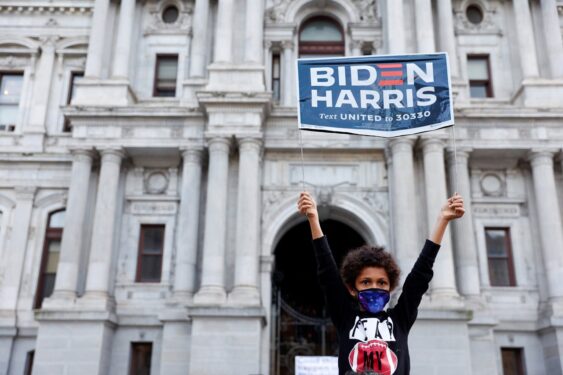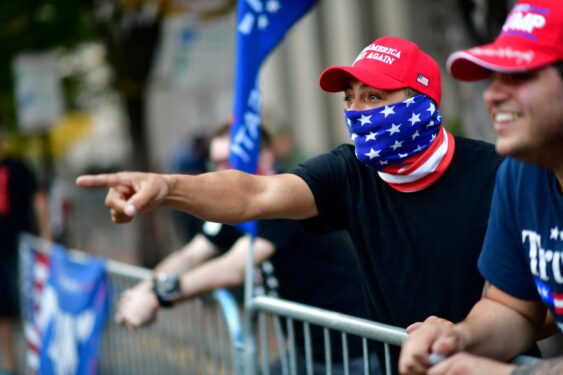
WINDSOR TERRACE — Nearly a week after the Nov. 3 presidential election, pundits still waited for precise break-downs of how Catholics voted.
However, preliminary data suggested that Catholics split their votes evenly among President Donald Trump and former Vice President Joe Biden. This result mirrored earlier presidential elections, including 2016, when Trump defeated Hillary Clinton.
This year, Catholic voters accounted for 22 percent of the electorate, with 50 percent of them backing Trump, and 49 percent favoring Biden, according to the AP’s VoteCast survey.
But in this election, it’s projected Trump lost key battleground states like Pennsylvania, which he won in 2016. He also lost other Rust-Belt states like Wisconsin and Michigan, which he won by less than one percentage point in 2016.
“Catholic voters once again demonstrated that they are the ultimate ‘swing-voters’ and that there is a real split between voters that identify as Catholic,” said Brian Browne, assistant vice president of government relations and adjunct political science professor at St. John’s University.
[Related: If Biden is Declared Winner, How Might He Handle Catholic Issues?]
David Gibson, director of the Center on Religion and Culture at Fordham University, offered another perspective.
“I think that just as 100,000 or so Catholics in a handful of Midwest states gave Trump the win in 2016, those same votes went the other way and cost him in 2020,” Gibson told The Tablet on Monday, Nov. 9. “But,” he added, “also don’t lose sight of the popular vote, where Biden really trounced Trump.”
It was unclear, however, how various ethnic groups who identify as Catholic specifically voted. Therefore, observers are awaiting the findings of the Center for Applied Research in the Apostolate (CARA).
Meanwhile, observers pointed to the overall vote’s exit polls for answers. While Trump kept his support among white evangelicals — eight in 10 voted for him — African Americans and Hispanics, both mostly Christian, favored Biden with overwhelming margins.
“Black Catholics are similar to Black Evangelicals,” Gibson said. “Their experience of racism in the United States and their theology focusing on helping the oppressed both shape their voting behavior in ways that are much different from white Christians in general.”
Browne added that black voters have long identified with and supported the Democratic Party. But Biden’s choice of Kamala Harris for vice president probably helped too, he said.
“Having the chance to cast a historic vote for the first woman vice president, who is also the first black woman, the first South-Asian woman, and the first daughter of immigrants to hold the role was certainly a motivating factor that transcended many racial differences,” Browne said.
Gibson and Browne also noted that the Biden campaign also communicated his lifelong Catholic faith very effectively, even though he is pro-abortion.
“On the campaign trail, Joe Biden repeatedly cited how his Catholic faith impacts his life, consoles him during times of personal loss and helps to shape his worldview,” Browne said.

“The Trump campaign,” he added, “took a different approach to try to win over Catholic voters by highlighting efforts that his Administration has made on issues of life, school choice, and religious liberty.
“For a closely divided Catholic electorate, different voters identified with the two divergent campaign approaches.” Gibson and Browne both said Biden might have had an advantage in the Rust Belt, having been born in Scranton, Pennsylvania. Still, the two candidates’ personalities and styles also played prominent roles in the election’s outcome.
“I think that Trump’s boorish personal behavior and apparent exploitation of a faith he did not seem to believe in really turned off a lot of Catholic voters,” Gibson said. “That may have been a bigger factor in pushing them to the Democrats than even Biden’s shared faith.”
Browne believes Trump’s campaign “had an angry and fearful approach as its central theme,” while Biden was “more forward-looking” and conciliatory.
“COVID-19 loomed large over the American electorate, and voters are tired, scared, and even angry at the government,” he said. “Those emotions do not help an incumbent candidate asking for another four years of service.
“Voters were looking for a change in direction at the top of the ticket, and they saw a better chance for that in the Biden-Harris ticket.”
Some observers suggested Trump’s actions on religious freedom and abortions pleased many Catholics, while others expressed disappointment on other issues that concern the Church, including immigration and the death penalty.
Gibson said many Catholic voters, like so many believers in the U.S., let their politics guide their faith, rather than the other way around.
“That’s unfortunate,” he said, “but it is the reality. So I think whatever your views on social justice were going into the campaign, Trump did not change them much, for better or worse.”
Browne and Gibson also noted other factors besides religion.
“It appears that an increased youth turnout in several key states may have helped propel the Biden-Harris ticket to victory,” Browne said. “Early analysis suggests that an increase of 10 percent in youth voter turnout — especially in some battleground states — helped as Biden had the support of 61 percent of voters ages 18-29.
“That may have been game-changing for Joe Biden, young Black, Asian, and Latino voters, respectively, supported Biden-Harris by overwhelming margins.” Gibson said, “Latinos in the Southwest were also key for Biden, and will likely be as critical for Democrats in the future as white Rust Belt Catholics are today.”
